Can it, Cannibals
Words by Star Apura Art by Kristi Brooks
Extra Extra!
Reports are coming in from cultural epicenters around the world that vampires have lost their status as the sexiest monster as they are replaced by something bloodier and better: cannibals. They are among us, hotter, more dangerous, and more mysterious than we’d expect. They sit in our lectures, shop in our grocery stores, scroll the same forums we do. All the while they are prowling for their next meal: Us.
Even with this sickening fact, we as a society still seem like we want to fuck them, but that’s just speculation. Yet, look at the new masses of Jeffrey Dahmer profile pictures littering Twitter. Dahmer is known for killing and eating 17 men: While this known fact stands, his Netflix show gained notoriety as the 12-hour porno-kill-buffet fest left its viewers wanting, even begging for more. People have always obsessed over him, many sending him love letters and even personal nudes while he rotted in his cell. As it seems, Jeffrey was not the only cannibal to leave our society insatiable.

Insiders a year ago must have suspected that the sexualization of craving human meat would become a sensation for American audiences. After all, Gen Z sex god, Timothee Chalamet, portrays a cannibalistic heartthrob in his newest movie Bones and All. Trend predictors knew that mixing carnage and coitus would result in horny viewers, and as it seems, there’s now a pattern emerging of casting sexy, alluring men of our generation as human eaters (i.e.,
Evan Peters as Jeffrey Dhamer or Sebastian Stan in Flesh). This idea of tantalizing men transcends the screen into real life: Chalamet’s past co-star of Call Me By Your Name, Armie Hammer, is currently hiding out after playing out his cannibalistic fantasies off-screen. He was last publicly heard via Instagram DM’s with the words, “I am 100 percent a cannibal. I want to eat you,” as he described his deepest, most innate sexual desires. Known for being a blonde lady killer, Hammer’s good looks have still gotten him some real-life pity from interested onlookers. He gets away with his abuse of these female victims, with the media and money on his side by painting his handsome face with innocence. Some people have gone even far enough to say he’s been framed, or that they would be willing to hide the possible criminal in their own homes.
The cycle rings clear. Evidently, our generation thinks good looks excuse gruesome acts.
Now, the question stands: Why are media consumers now consuming human consumption? America, the capitalist machine that it is, finds itself diving deeper and deeper into the lives of the murdered. It must consistently find something bloodier, something to make people truly shake after hearing their latest podcast. Researchers say that quite possibly, these true crimer listeners were the ones who brought the cannibal onto our screens. Their interest in slaughtering resulted in the need for the latest grossest criminal. Sure, some may say that they listen for education, some for interest in the psyche, and others for the thrill of it all. But all still play into the AI algorithm understanding that the people want the bloodlust, and then they want more Do we think there’s a way to stop this downward spiral? Before we find the new social obsession that could be even worse than humans eating humans? Until then, we have to find a way to stop this obsession with cannibals.
The Hysteric Issue 9
Unattainable beauty standards have existed since the beginning of time and the establishment of the patriarchy. Created not by society, but by a seemingly omniscient patriarchal authority, they are upheld through social media, entertainment media, visual art, etc. Men are unlikely to acknowledge this, but these benchmarks impact both men and women, instilling within them a sense of neverending unworthiness and determination. More often than not, humans are insecure beings, and whether that insecurity is physical or mental, it will always exist in a society with ever-changing standards for physical and mental beauty. The modeling industry is one place where these standards are the most prevalent. Victims of the beauty industry (celebrities, models and women in general) will do whatever it takes to feel as though their body is allowed to take up physical space.
This theme is discussed heavily in The Neon Demon, an arthouse horror film starring Elle Fanning (Jesse), Jenna Malone (Ruby) and Keanu Reeves (Hank). It chronicles the story of a newcomer to the modeling industry, 16-year-old Jesse, and the people around her who take advantage of her naivete and strangely alluring appearance. Ruby, Sarah (Abbey Lee) and Gigi (Bella Heathcote) are the film’s supporting female characters, who are growing unwanted in the industry because of Jesse’s emergence, so they befriend her to gain her trust.



While supporting male characters Hank, Dean (Karl Glusman) and Jack (Desmond Harrington) look to exploit her for fiscal and reputational gain,

10
Jesse’s ego is raised to insurmountable levels by their attention. They abandon her upon realizing what they’ve created, a move that gets Jesse murdered and cannibalized by her supposed “friends,” who hope to obtain the mysterious “it factor” she has. In the end, Ruby and Gigi die horrific deaths as “Jesse” tries to escape their bodies, while Sarah is able to stomach the guilt and maintain her newly gained ounce of relevance in the industry.
Although women are generally thought of as more trustworthy than men, The Neon Demon exhibits that, no matter the person, their animalistic opportunist nature will take over. The women in the film capitalize on Jesse’s blind, naive trust in their intentions: Ruby gains Jesse’s friendship, and after isolating her tries to assault Jesse, Gigi and Sarah earn sympathy from Jesse as they are being ousted from the industry, so they capitalize on that trust and murder her, and Roberta (Christina Hendricks) presents herself as a mother figure for Jesse when, in fact, all she wants is another client that she can monetize until they lose their spark. The men take advantage of her growing confidence and assumed maturity to appease a sense of male entitlement. Hank prostitutes her physical beauty because Jesse is not paying her rent at his motel, Dean utilizes her physical beauty as a way to break into the photography industry he believes he deserves and Jack exploits her physical beauty as a way to revitalize his brand. The film’s male characters spark Jesse’s downfall, but the female characters are the shovels that bury her.

A topic touched on in The Neon Demon is the question of whether or not women should get plastic surgery to obtain the “it factor” with which some, like Jesse, are born. In the film, that factor is not something that can be achieved through plastic surgery, which is seen as a cop-out or a temporary band-aid as their influence seeps through the sides. Gigi is mocked and publicly humiliated by a designer, Jack, whom she considered a friend. At dinner, Jack makes Gigi and Jesse stand next to one another and starts comparing the two, asking Jesse’s boyfriend, Dean, to choose who he thought was prettier. Jack then goes on to point out all the things wrong with Gigi, one of those things being her multiple plastic surgery procedures.
However, this notion is in opposition to the reality of societal expectations. Plastic surgery is a somewhat requirement for celebrities and the highest-paid models in the world. Perhaps the most influential figures in modern society, the Kardashians and Hadid sisters, all utilize their abundant wealth to create and maintain the “perfect”


physical appearance through obviously physically altering procedures. Even though all of the world knows (some judgemental and some not) they have undergone these surgeries, all of them deny having gotten any work done. All this denial does is contribute to impossible female beauty standards: “If you just work out and eat healthy every day you can look like me too!” When, in reality, they look that way because they’ve paid for this “look.”
However, if plastic surgery is botched, the power shifts from the public figures to the public themselves. They are judged and ridiculed relentlessly by media and society e.g. Courtney Cox, Jennifer Gray, Melanie Griffith, and Pricilla Presley for nothing other than having had a procedure gone wrong. Plastic surgery, then, is a tool that has crafted some of the most beautiful women in the world, while simultaneously creating the exact opposite.
Another topic majorly discussed in The Neon Demon is the exploitation of young women and their inherently naive and trusting nature, as well as their desperation for success and acknowledgment by prominent figures in the modeling industry. The entertainment enterprise (modeling, movies, tv, music, etc.) will love-bomb young new talent in order to drain them of all the content and monetization they can before they throw them out for the freshest, newest look. The in-and-out nature of modeling encourages this acceptance, wherein you do whatever you can to survive and keep working. However, even after the trials and tribulations you are put through, once your spark has fizzled you are kicked out. Insanely famous artists like Lady Gaga, Evan Rachel Wood and Brendan Fraser have spoken out about their horrific experiences involving powerful people in their respective industries, but the stories that are not heard are those of the “regular” person who doesn’t have the influence or connections needed to be taken seriously.
In 2022, cosmetic surgeon Julian De Silva named Bella Hadid the most beautiful woman in the world. This declaration upheld the intensely unreachable standard of physical feminine beauty. Women are told they have to abide by a certain set of standards to be worthy of their place on their earth. If they are not the beauty standard, it is expected that they have plastic surgery, or find another area in which to be immensely talented. If they are the beauty standard, then their entire lives will be spent sprinting trying to keep up with the never-ending cycle of physical trends. The Neon Demon does a great job of depicting how far women with physical beauty are willing to go to maintain their worthiness, and how women without physical beauty will seek validation from those that are.
The Hysteric Issue 11


12

The Hysteric Issue 13
It was another one of Zinnia’s regularlyscheduled existential crises. Like clockwork, they came around every few months: She’d wake up mid-afternoon, and decide that the rest of the day was wasted. Before she knew it, the rest of the week had flown by too.
While Zinnia could usually predict these low periods, she never could foresee their end. When she could muster the motivation, Zinnia would dip her toes into self-care; She’d clean the apartment a bit at a time, or make a good meal.
Today, she crawled out of bed around 4 p.m., looked at her bookshelf and felt that familiar twinge of self-preserving motivation. The weather was nice enough, so she grabbed her new paperback and headed to the park before she could change her mind.
It didn’t matter that she was still in her decade-old Hello Kitty pajamas, it wasn’t like she going to talk to anyone.
Zinnia wouldn’t call herself antisocial,
but she definitely wasn’t an extrovert. She wouldn’t avoid conversation with a stranger, per se, but she also never actively sought it. This is why she didn’t outwardly twitch when a tall, sun-aged woman sat a bit too close to her on the park bench.
“I used to love that book,” the kind-eyed stranger said.
“Used to?” Zinnia responded.
“I don’t have much time for reading these days. I don’t miss it too much until I remember titles like that.”
“I’m Zinnia,” Zinnia volunteered only because she wanted the stranger to do the same.

“Oh, how beautiful,” the stranger exclaimed. “It suits you.”
Compliments always made her uncomfortable, especially when they came from someone she didn’t know. But this was different, this woman’s face was welcoming, almost familiar. Zinnia smiled.

14
“I go by Sunny,” the stranger finally offered.
“Nice to meet you,” Zinnia said.
The stranger didn’t say anything but continued to smile warmly at Zinnia.
To break the silence, Zinnia said, “My mom named me after her favorite flower. We never had a garden, but she’d paint them to hang in our apartment.”
“What a lovely story! We have the most beautiful garden at my family home. It’s just across the park.”
Zinnia has always appreciated flowers, but her liking became a strong passion after her mom died two years ago.
It was almost sundown and getting chilly, but Zinnia was enjoying herself and her conversation with this maternal stranger.
“I haven’t been in charge of tending the garden since level two, but I do believe we have some zinnias planted in the back,” Sunny beamed. “You should come to visit sometime!”
Zinnia flinched slightly at the invitation and ignored her urge to ask what level two is. Every time she was among flowers she felt close to her mom.
“I’d love that,” Zinnia replied.
Sunny’s already warm face brightened.
“That’s excellent news! It’s too dark for you to appreciate them now, but how about tomorrow morning?” she asked. “I’m sure my family would love to welcome you for breakfast.”
It wasn’t often Zinnia had a convincing reason to get out of bed, especially not recently. It was even less often that she’d do anything to push herself out of her comfort zone. Not to mention, she loves breakfast food if she can wake up in time for it.
“Ok, sure,” Zinnia agreed. “What time?”
“Is nine too early?”
Zinnia felt like she could be honest with Sunny, and nodded before she could think about it.

Sunny laughed and said, “Ok, let’s call it
10:30, then.” - - - - - -
As Zinnia approached the address Sunny gave her, she could have sworn she was lost. If the address was correct, she was walking onto a farm in the middle of a residential neighborhood in suburbia.
She stopped to check the address on her phone, and before she could take another step she heard Sunny.
“Good morning, my flower!”
Zinnia looked up at her new friend. “This is your family home?” she said in disbelief. “This is a whole compound.”
Sunny laughed and squeezed Zinnia’s shoulder.
“You’re beautiful and funny this property has been in the family for generations, the city built this neighborhood around us over our father’s dead body. Literally.”
Zinnia didn’t know what to say. She was certainly intrigued.
“All that just to say we have earned our place here,” Sunny said. “Come on, beautiful girl.”
As Sunny led her past a big red barn and countless flower and vegetable beds, Zinnia felt transported to the countryside. She had never been out of the city before but always dreamt of leaving.
They approached a group of people chuckling as they served themselves buffet style: There was sausage, bacon, waffles, and every breakfast food you could think of.
Sunny whistled to get everyone’s attention.
“Hey everyone! This is our new friend Zinnia,” she announced. “Please give her your warmest welcome.”
This was definitely an odd experience for Zinnia – but then, she hadn’t ever really experienced much.
“Um hello,” Zinnia said hesitantly as she shoved her hands in deep into her pockets.
As she and Sunny began to make their plates, Zinnia learned the 16 names and fac-
The Hysteric Issue 15
es of Sunny’s family.
Up until this point, Zinnia assumed that Sunny had been referring to her biological family. But meeting them made her reconsider what family really meant. Maybe, you really could choose your own. Since she lost her mom she had been searching for a family of her own: A chosen family.
- - -- -
Breakfast was delicious and Zinnia was stuffed. A
good meal has always been the way to her heart.
“Do you do this for breakfast every morning?” Zinnia asked the table.
“Pretty much,” the man she learned was called Baron said. “We’ve got to put our hens’ eggs and the meat of our pigs to use.”

“The waffles are Ida’s handiwork” Sunny chimed in and gestured to the oldest woman of the group.

“We usually eat earlier but Sunny insisted we wait for you,” Ida said.
Zinnia was more enchanted than insulted. Farm living had always been a distant fantasy to Zinnia. It represented everything she longed for: Tending to a garden, a closeknit community, sustainability and somewhere other than a concrete apartment to call home.
Sunny cleared her throat, “Would you like to stay here for a few days?”
It was like she read Zinnia’s mind. In any other circumstance, Zinnia would have been skeptical but Sunny, her family and their land have been more welcoming than Zinnia’s father and distant relatives have ever been.
“I’d love to,” Zinnia said. “I’ll have to go home to pack a bag. And where should I
park my car?”
“Oh, you think too much beautiful girl,” Ida said.
- - - - - -
The first night at Sunny’s home was a sleepless one. Come bedtime, Zinnia was sent to one of the four cabins on the property. When she opened the door she saw the other youngest women who were at breakfast.
They introduced themselves and Zinnia felt at home immediately. She was bunking with 4 other girls: Daisy, Rose, Lilly, and Azealia.
Zinnia guessed that Rose was in her late twenties but she snored like an octogenarian. But it wasn’t the noise that kept Zinnia awake.
The cabins wrapped around the open space where they had breakfast, and in the middle was a stadium light. None of the windows in the cabin had curtains so the light shone into every corner of the bunk room. None of the other girls seemed to mind.
After the longest night, Zinnia could not have been more ready to hop out of bed when the roosters called at sunrise. She didn’t know where to go or what to
16
do so she wandered out to the barn. Sunny was collecting eggs from the coop and greeted Zinnia with her usual warm smile.
“Baron will be up soon, won’t you help me start breakfast?” Sunny asked.
Zinnia reached for the basket of eggs and Sunny led her to the milk cow pens.
“Would you hand me that bucket?” Sunny asked as she sat down and rubbed the cow’s belly.
As Sunny started to milk the cow, Zinnia blurted, “What’s with the bright light?”
“Oh,” Sunny said, “Baron says it is to deter animals.”
“But we’re in the suburbs.”
“Beautiful girl, the suburbs were built on nature,” Sunny said with a sad smile.
- - - -
Before she knew it, Zinnia had been on the farm a week and a half. She woke up in the brightly lit cabin after a good night’s sleep and the sweetest dreams.
At her old home, Zinnia lived alone. She thought she liked to be alone until she came here.

“Good morning Daisy, Good morning Rose, Good morning Lily, Good morning Azaelia.” Zinnia yawned as she stretched her arms.
“Good morning Zinnia,” they said in unison.
She had gotten used to mornings like these. But today was different.
- - -- -
“Do you ever talk to your dad?” Sunny asked at breakfast.
“Not often,” Zinnia said. “I talk to him once every few weeks or so.”
“You need to cut ties with him.”
“Um, well, ties are sort of already cut, we basically just
check in with each other because we both feel like we have to,” Zinnia explained. “Well, you don’t. Have to, I mean.” Sunny said.
“I guess not,” Zinnia said. “But it feels good to at least know someone is out there thinking about you, no matter who they are.”
“You have us now. We are your family,” Sunny said. “You don’t need him.”
Zinnia agreed. She hadn’t ever felt a sense of belonging like this, certainly not from her family and so-called friends at home.
“Here we believe the family we choose for ourselves is the most important thing,” Sunny said. “Everything else comes in second place.”
This was foreign but appealing to Zinnia. Her biological family had never been anything to brag about. When her mom was alive, she and Zinnia’s father fought constantly. It wasn’t rare for Zinnia to wish she was anywhere but their too-small city apartment.
For the first time, Zinnia felt at home. “You are my family,” Zinnia agreed.
“Never forget it,” Sunny said.
The Hysteric Issue 17
“The mean reds are horrible: Suddenly, you’re afraid and you don’t know what you’re afraid of. Don’t you ever get that feeling?”
“Sure.”
“Well, when I get it the only thing that does any good is to jump into a cab and go to Tiffany’s. Calms me down right away. The quietness and the proud look of it: Nothing very bad could happen to you there.”
– Holly Golightly, Breakfast at Tiffany’s
I don’t really know when my worries about death began, but I can tell you this: My mom’s started with a sudden onset of anaphylaxis.
It’s a story I’ve been told my whole life. One minute, I was blissfully enjoying my infancy, the next my throat was closing up. Thankfully, it happened before I could comprehend much of anything, before I had any awareness of my own breathing.


My mom, on the other hand – well, this was just the beginning of her hyperfixation on my respiratory system.
And that’s normal, I think, an irrational preoccupation that any parent would have after their child’s neardeath experience. Except in her case, life reaffirmed that it was rational, to some degree, when a severe asthma attack sent my brother to the hospital four years later.
After this, my mom stayed up with me every time I got sick – she would lay awake beside me in bed for as long as she could, watching as I drew out each and every breath.
“Does your chest feel tight?” she’d ask me.
Sometimes it did, especially as I got older and the reality of everything that could possibly lead to my untimely demise started to settle in. Like Holly Golightly, I’d get the mean reds, only I knew what I was afraid of: Accidental chemical inhalation, forgetting to take that tampon out, the sudden onset of some rare and deadly disease.
So, when I felt that shortness of breath return at 19 years old, there was only one discernibly obvious explanation: Lung collapse.
18
My two roommates laughed off the theory, but nonetheless drove me to the nearest emergency room. There, a very obviously annoyed nurse conjectured that I had a generalized anxiety disorder and needed to stop drinking tequila (I would like to state, for the record, that I had not consumed any prior to the visit – I think this was projection).
But it’s a common reaction, isn’t it? Women are constantly told that it’s all in our heads, that we’ve allowed emotion to overcome rational thought. That nurse didn’t run a single test before telling me that all I had was anxiety: He gave me five minutes of time to plead my case before dismissing it.

I wish I could tell you that my Great Lung Collapse Odyssey of 2020 ended there, but I wouldn’t be me if I wasn’t persistent in my pursuit of medical treatment.
It was at my second urgent care that I met the nurse that fundamentally reframed my understanding of what it means to suffer from anxiety. I unfortunately cannot recall her name, which is probably a bit terrible of me, but I digress.
“You just need someone to listen to you,” she told me. “To tell you that you’re going to be okay.”
We talked for a long time after that: She validated my pain, even if it wasn’t actually physical, and convinced me not to have them run a bunch of costly and, let’s face it, unnecessary lung tests. Most importantly, she took me seriously – it’s like this oft-quoted (and unfortunately reclaimed by TikTok) line from the Deathly Hallows:
“Of course it is happening inside your head, Harry, but why on earth should that mean that it is not real?”
It’s easy to dismiss feelings when you aren’t the one that’s struggling to explain yourself through an unrelenting tightness in your chest. I even do it to myself, when some time has passed – nothing ever feels real in the retrospective. It was a waste; Precious minutes, hours, sometimes even days lost worrying about something that never existed.
Only, it does exist. It’s like that nurse told me, and like that quote: Pain shouldn’t be dismissed because its cause isn’t physiological. The reality of its existence isn’t predicated on its origin – it can still be felt, even if it is in your head.
What I’ve come to realize is that anxiety manifests differently in all of us. For me, the thoughts in my mind are tied very viscerally to what I feel in my body: When I’m anxious, it’s a physical sensation. That feeling spreads through my arms, my chest, my stomach and head. I get dizzy, nauseous, I struggle to breathe. Worst of all, I’m afraid, and that fear feeds the never-ending spiral in my mind.
When I’m most aggrieved by these thoughts, I’ve
turned to the internet, a space that’s been both good and bad.
The internet will tell you that there are two ways in which people cope with medical anxiety: Either by seeking out professional care or avoiding it entirely. I did the former for a long time. I found my Tiffany’s in the assurance of doctors, nurses, anyone that I believed in enough to affirm my continued sustenance. Like Holly, I found a hiding place from the mean reds in their care.
I think it’s really easy to dismiss health-related anxiety as something to be laughed at: Media likes to do it, friends, family. Hell, I used to laugh at it myself. It is, after all, a hard problem to admit that you have, and an even harder one for which to find coping mechanisms.
Before I got to college, I didn’t understand what taking care of yourself meant. Then, suddenly I was here and that phrase was everywhere – in emails from the school, stamped all over my syllabi, in brightly colored infographics on social media. “Take care of yourself,” they screamed at me in aggressive but cutesy all-cap fonts.
I didn’t buy into it at all at first, mostly because I just didn’t understand what the phrase meant. I take care of myself every day. I get up, I feed myself, get dressed for work, pay my own bills. Like a lot of other students, I am taking care of myself.
And like many women, I feel responsible: For myself, for the people around me, for the improvement of some greater condition that is far from my control. And again, like many individuals, both male and female, I compartmentalize the stress that accompanies this sense of responsibility until I hit a wall and can no longer keep going.
In my case, it’s always felt easier to search for an alternative answer to why I’m feeling the way I am than to admit that I might actually just be tired, stressed out, or overwhelmed. I also find myself diverting stress from other areas of my life over to these mystery ailments, latching on to them as a reasonable excuse to slow down. “I can’t keep going if I’m sick” –sometimes this feels like the only acceptable answer.
What I’ve come to realize about these moments is this: They come to me when I am my most drained, when my body cannot physically tolerate any more stress. Anxiety strikes at your most vulnerable points, when you’ve neglected your self care and left yourself defenseless. It’s hard for me to stop, to admit that I can no longer take care of myself.
So, yes, the pain isn’t exaggerated or hysterical or fake. It’s not because of drinking too much tequila. It’s the crushing pain of struggling against the weight of a burden you can no longer carry, of trying to stand as it holds you down. And that’s about as real as it gets.
The Hysteric Issue 19

20

21
Art by Charlotte Benson
It’s not easy being lazy.
What people don’t ever mention is the tyrannical obstacle course from hell that develops in our psyches when we are unproductive. Some may call it self-afflicted, but I used to call it my equilibrium.

I feel that I am in my element when my mind is clear of all responsibilities, of all truths about what I need to be accomplishing. However, when I look at my closest friends and peers, who all seem to know what they’re doing, envy fills this empty, vain pit inside me with enough agency to get up and do something with my life.
But, as I continue to add more and more onto my plate, I find myself asking this: Why do I keep doing this? I keep feeding and eating all these colors, but they don’t mean anything to me. Yet, I hate that I love the hue it gives me. I like the color it gives my veins and I love to show it off to my friends and my parents and say “look, I’m being a productive member of society, am I doing it right?”
While I think that this socially enforced productivity is a phenomenon that affects
every person equally, I also think there is something to say about the effects that the American capitalistic cog machine has on the immigrant mindset.
I know…me know big words and me put in long sentence. But no one ever really mentions this omnipresent generational guilt: As a first-generation immigrant, we work hard off the memory of the American Dream, our parents achieving something from nothing.
I have all these opportunities to do something bigger and better for them, to prove that their struggle wasn’t just for their daughter to lay in bed and waste away. Constantly needing to pile myself with work, projects and roles because the blush of not filling my mind with perpetual stimulus burns if I’m not working to be successful.
But after doing this a while, I’ve come to like the blaze. I’m addicted to the hurt, the ephemeral gratification, even if it’s self-sabotage. I love feeling like I have purpose in my life, especially when it’s not even close to the truth. Even if I fail, at least I’ll be adequate. I take those nasty, wretched colors and stain myself anew.



24

The Hysteric Issue 25


26

The Hysteric Issue 27


28

29


30
Words by Maria Probert Hermosillo Art
by
Avery Fox

The Hysteric Issue 31




32
People always tell you not to lose yourself in a relationship. While this is typically said in reference to a romantic relationship, I didn’t experience it until I found myself obliterated by a friendship. After an intense and traumatic five months, I had never felt less like myself: It was as if I didn’t even exist in my own world anymore.
Between October 2021 to February 2022, I gave my all to a close friend that all but manipulated me through emotional and situational triggers I had disclosed early on in our friendship. In an effort to sympathize with and support someone going through, almost eerily, exactly what I have lived through, I became one of her only two support systems, and started to feel isolated while also trying to control the effects that these triggers had on myself. Despite the fact that this brought me back to the old habits and unhealthy lifestyle of my past I had worked so hard to heal from, I truly believed that it was all for the good of someone I loved.



The morning of Feb. 7, my reality came crashing down. I got a call from my friend’s family member, who informed me that the last five months were all a lie. The emotional rollercoaster I endured supporting someone post-SA, the self-harm tendencies turned self-destructive and suicidal actions, and the alarming family issues were all stories made up from details of the lives of the people closest to her, myself included. She had used the trust she built with the people who were vulnerable with her to garner sympathy, attention and unrelenting love. I had never felt so violated in my life. Intimate details of my trauma and experiences I disclosed to someone I had come to trust more than some of my long-term best friends were used against me, against my compassionate tendencies.
When all of this was over and I finally told my parents what had all happened, the first question my mother asked me was, “Why didn’t you ask for help, or involve an adult when it clearly became bigger than you?” I had a lot of answers to that question, and a lot of excuses. But she was right. The bottom line is this: No matter how strong, some things are too heavy to be borne by your own selflessness. Friends, family, partners -- nobody should be demanding all of you for all of them. When the whole of you gets torn apart by someone else, very rarely are they the people who would help build you back up.
After this traumatic downfall, I thought that my trust issues would heighten to a new level. Make me close off again, become a shell of a person. But after days of crying and talking and almost going actually crazy from my reality shattering, I found peace within myself. While I learned many important lessons about self-preservation and creating healthy boundaries, I was also proud that I am the type of person that would, without hesitation, give my all to someone I loved whenever they needed me.
Like most characteristics, that is very much a double-edged sword, but the compassion and empathy that lives within me is how I build trust with the people in my life. Everyone’s always said that one of my greatest qualities is my ability to connect with others and be a shoulder to lean on in times of need. I give my strength to others, I give me knowledge to others, and I give my trust to others. I hope that I never lose these qualities, but I also hope that I learn to give to those who are worthy of receiving them. That I don’t trust blindly and give blindly without knowing that, when I’m in need, I’ll receive the same compassion. And that whenever I’m unable to give and give and give, that they would allow me the space and support to put myself back together.
You are not everything to everyone all the time. But, you are, in fact, everything to yourself all the time. What happens when you keep giving pieces of yourself to others without withholding some for yourself or replacing those given? The puzzle of your own life will come apart, and putting the pieces back together will seem all but impossible. Give what you can, take what you need and find the people who will help keep your puzzle together.
The Hysteric Issue 33
I hate what Gen Z has done to AAVE: African American Vernacular English, a way of speaking pioneered by and created for Black individuals. I hate how they’ve taken a hold of African American slang, just to dilute the once-potent language and claim it as their own. How, if I Google “Gen Z slang,” every article that appears will list words that Black people created long before Gen Z was even a thought. How I can no longer use slang tied to my culture without someone critiquing me for having an “Internet personality,” when they should be critiquing non-Black people on the Internet for making Black culture their personalities.

Instead, it seems they’d rather enable them, giving non-Black individuals from my generation far too much credit. Every headline is always some variation of what makes Gen Z “different” from the rest, as if gentrification doesn’t run rampant through its core. As if “Gen Z culture” isn’t just cherry picked elements of Black
culture that’s been rebranded and sold as otherwise.
Yet, when I voice these thoughts, few people ever seem to get it — like everyone can hear me, but no one’s really listening.
I’m listening, though.
How can I not, when non-Black individuals have begun to sound like an imitation of me without understanding the nuances of what they’re imitating?
They don’t understand that my most impressive skill is how quickly I can code switch, after having non-Black people tell me all my life that the way that I speak is unprofessional. But I guess that’s only when AAVE comes from the mouths of its originators. Because now, every corporation wants to utilize “it’s giving” and “slay” in their marketing to better connect with their target audiences. But those audiences are never the Black people who created these words.
It’s always the non-Black members of

34
Gen Z, the ones who’ve unrighfully claimed the slang as their own.
I’m listening as nonBlack people sprinkle AAVE into their day-to-day dialogues like it’s the punchline of a joke I must have missed. Everyone else seems to have heard it, though. Because there’s an uproar of laughter each time.
I remember sitting in class as a white kid raised their hand to let the professor know “You so real for that.” Everyone laughed. Maybe it’s just me, but there’s nothing humorous when I have to be careful of where I use my slang, otherwise they’ll call me ghetto. But this kid can do it without a care in the world.
The professor and I both stared in confusion.
Perhaps she found it as strange as I did to hear our slang being spat back at us. That’s the other thing: AAVE never sounds quite right coming from people who don’t understand the conventions and history surrounding the language. I imagine it becomes almost like poison the second it reaches the lips of someone it shouldn’t, and that’s why the words never roll off of their tongues the way they should. Because their bodies are rejecting what they know doesn’t belong there.
I’m still listening, even once they’ve grown tired of the slang that didn’t belong to them in the first place. How they critique the language after they ignored its conventions and made it into something else.
I stare in confusion. Especially when they feel the need to ask why I’m using “outdated” words, as if my mother didn’t
use “point, blank, period” all throughout my time of growing up, long before Gen Z thought it was trendy and cool to say.

AAVE has no expiration date when its home is the mouth of the one whose culture originated it. In fact, it thrives when used amongst Black individuals. It comes out effortlessly. Like second nature. It only dies when removed from its natural environment and forced into a space where it doesn’t fit.
But, now that Gen Z has taken AAVE and made it so ingrained into their personalities, I’m afraid that what I say may be in vain. They’ll tell me that I can’t gatekeep words, or that culture is meant to be shared. But why should I be expected to share with the same people that contributed to the negative connotations surrounding my slang in the first place?
And worst of all, I know that even once they reach the end of this essay they’ll pretend they didn’t see anything and continue with their dayto-day gentrification of Black culture. Like nothing ever happened. Like they heard me but weren’t really listening. Yet again.
But I’ll still be here. Talking to what feels like only myself as the hysteria sets in after realizing you can’t make people care about something they only see as disposable.
But I’ll always care. How could I not?
The Hysteric Issue 35
Our world is full of rushed jobs: Care is sacrificed for efficiency, detail for the sake of having a product to sell at all.
By now, I’m sure we’ve all felt this sort of shift in the experience of buying and owning clothing. Blame it on the pandemic, on TikTok, whatever; No matter your answer, it’s undeniably true that the speed with which the cycle of what is and isn’t “in” has changed considerably. And so has the supplier of these “in” products: Even Zara, mother to the oft-bemoaned fast fashion industry, is now dwarfed by the big, bad SEO-driven Shein, and the term “micro-trend” has become a staple in our collective vocabulary over the past two years.
As social media and consumer data collection drive this ever-accelerating trend cycle, it in turn motivates companies to abandon quality standards in clothing production, increasing textile waste and the risk posed to garment workers. If you’re anything like me and you spend way too much time worrying about things you’ll never have any control over, then that means you’ve probably asked yourself this question: Why do we continue to allow highly problematic companies like Shein to sell their products at all?
The answer’s actually pretty simple. Aside from the fact that I’m sure our country’s leadership doesn’t receive very many targeted ads for its products (which are seemingly mostly marketed to young women), regulating trade with
 Words by Hannah Rossi Art by Nidhi Malpani
Words by Hannah Rossi Art by Nidhi Malpani
the company would actually involve regulating trade with its host country.

Companies like Shein are what economists call multinational corporations, or MNCs. What makes an MNC “multinational” is that it is based in one host country, but chooses to engage in foreign direct investment, which is basically where a company sets up shop in other countries in exchange for certain incentives.
So what can the overwhelming success of a company like Shein tell us about the state of global politics and trade regulation?
I’m just going to assume you’ve taken a basic econ course and skip over the whole supply and demand equation – we all know that companies make things that they know consumers want to buy. We also know that they want the cost of this production to be as low as possible so they can extract the largest gains.
When MNCs choose between countries with which to engage in foreign direct investment, they’re looking to ones that will allow them to maximize efficiency by cutting as many costs as possible. Labor, especially in a manufacturing-intensive industry like clothing production, is typically the largest of those costs. So, when engaging in FDI, companies with labor-intensive manufacturing processes look to countries with looser regulatory standards.
36
Art by Ella Barnes

37
Everyday we all play one big, never-ending game of telephone, both in-person and online. As we express ourselves and simultaneously consume a vast sea of information, it’s easier than ever to misinterpret things, to condemn or glorify one another, and to get carried away to polar extremes. We are balls of pure emotion, raw nerves shouting into an echo chamber, agreeing and disagreeing with each other but rarely making actual connections. Each of us resides in our own bubble of beliefs; true sincerity is often buried under layers of irony; small things are blown out of proportion and big things are overlooked. In a generation of such individualism, it seems we’re becoming more homogenous than ever.
HYSTERIC is a crystallization of this chaotic moment in our culture. HYSTERIC dares you to act outside of what’s expected, with reckless abandon.

In recent years, ORANGE has evolved. Once a newspaper-style publication centered mainly around local Austin events, our content has increasingly shifted towards creative writing and graphic design. Accordingly, our zines have reflected this shift. It’s been an honor to help lead such a talented all-female staff in producing this body of work.
I’m so proud of what we’ve accomplished this semester. To Hannah, our Editor-in-Chief, I can’t thank you enough for your commitment to ORANGE. You light up every room you walk into and know exactly how to balance out my Type B brain. To my creative team, getting to know each of you has been a joy. Your artistry knows no bounds and I can’t wait to see what you make in the future. To Avery, my insanely talented Design Head, this zine couldn’t have happened without you. I’ll never forget the countless hours we’ve spent together, whether we’re singing show tunes while typesetting or psychobabbling over FaceTime. You’ve helped me grow as a designer and I’m forever thankful. Although this was my last semester in ORANGE, I can rest easy knowing you will do great things as Creative Director next year. I love you all and will miss you dearly.
With love, Spencer Hickman, Creative Director



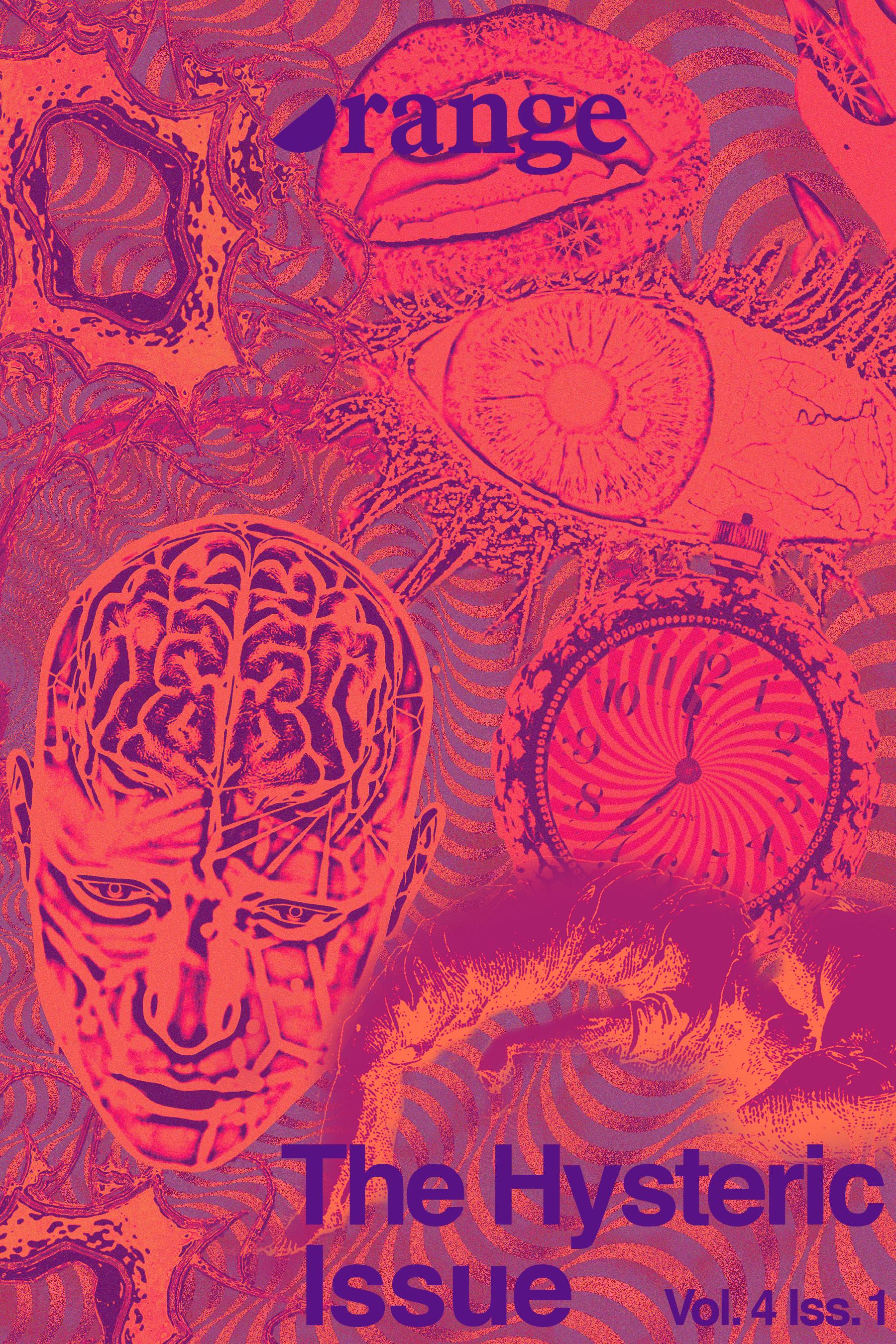

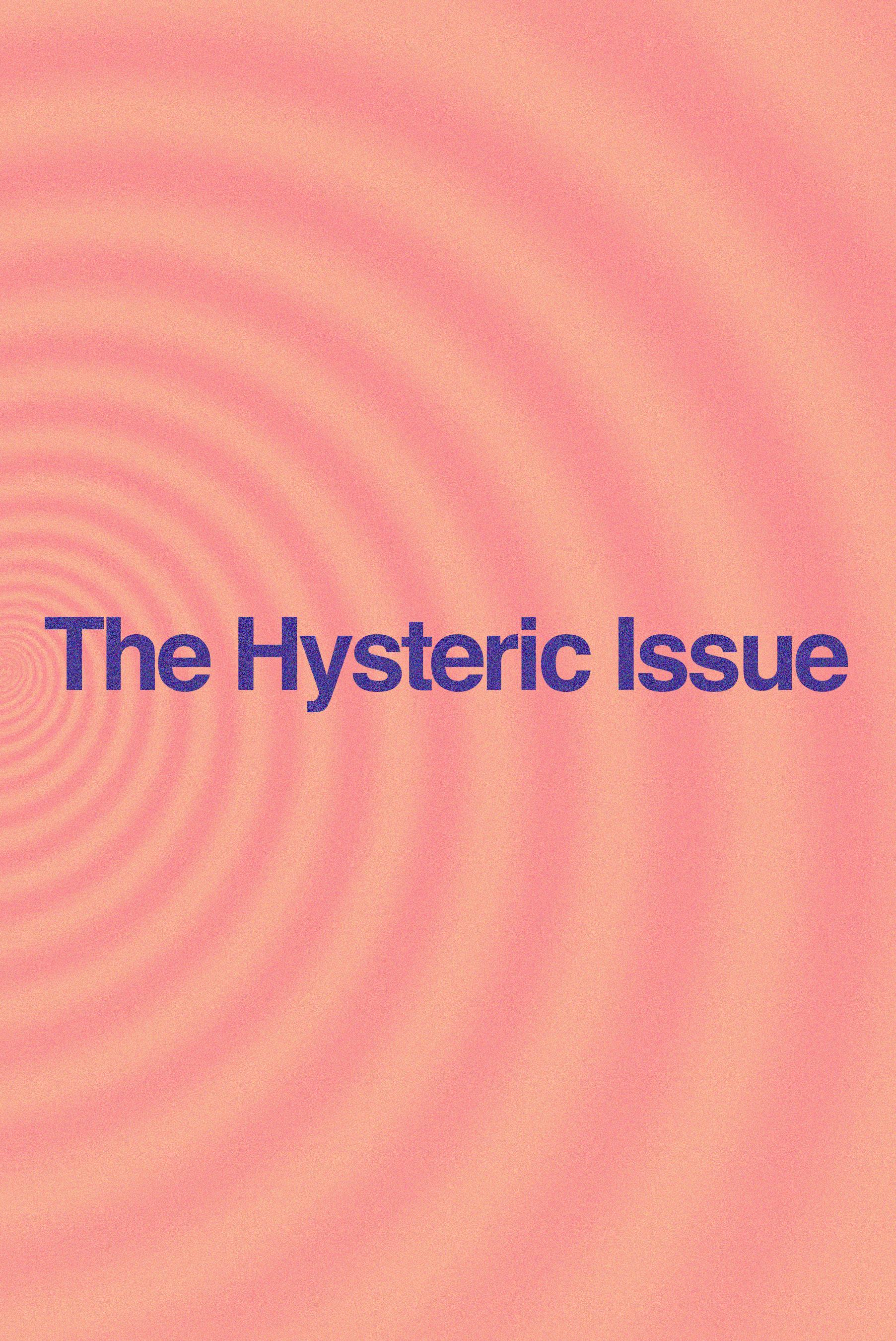
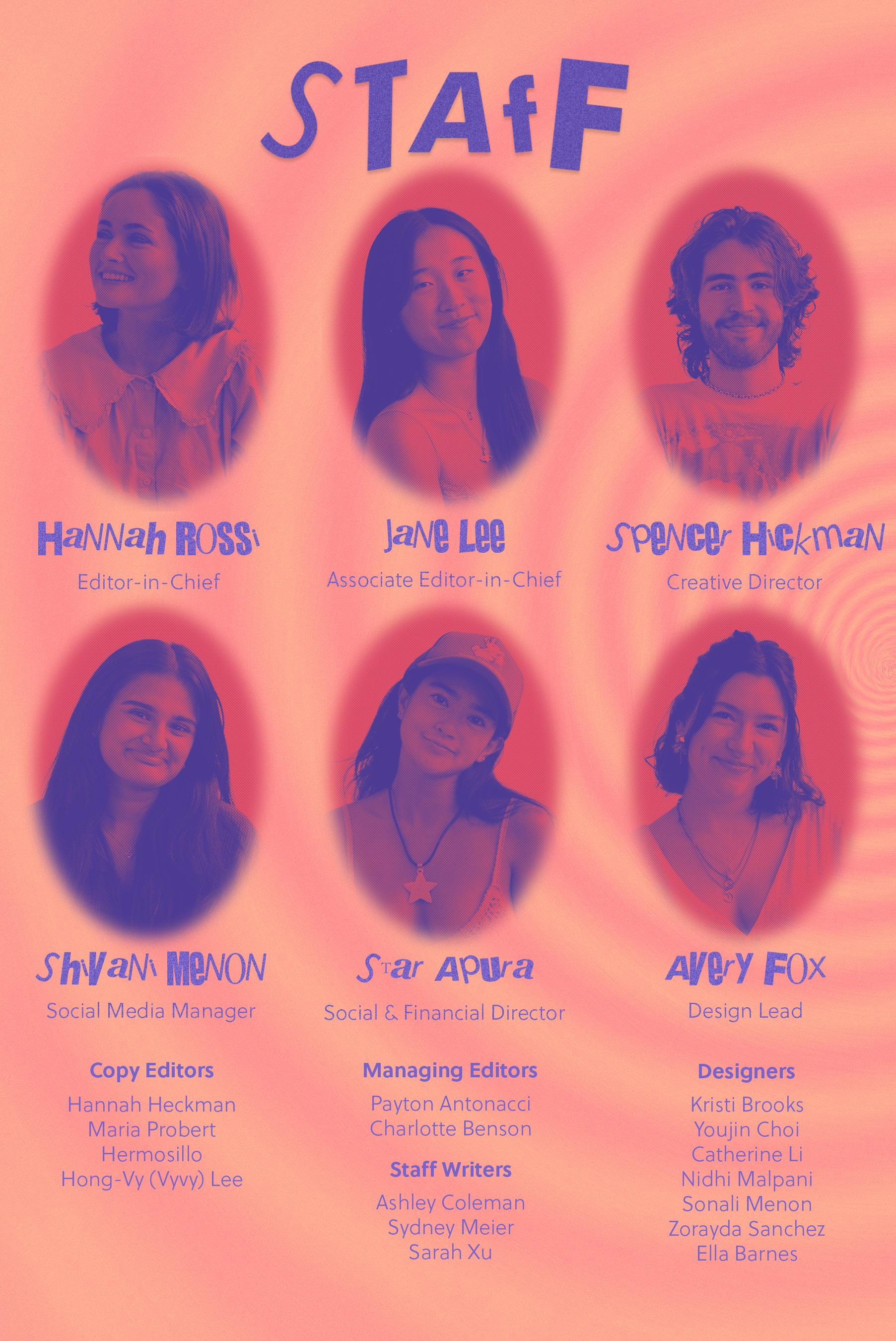

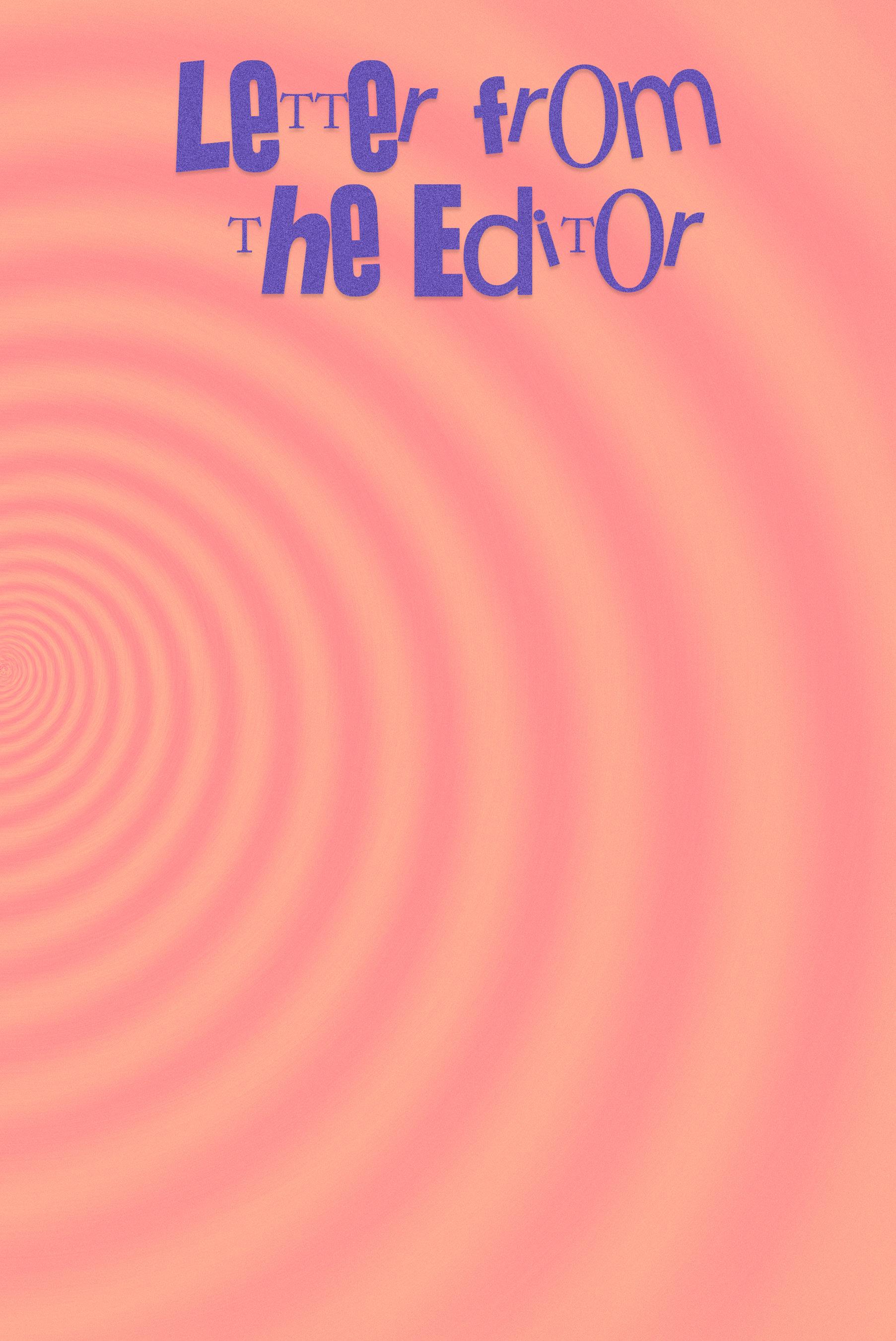




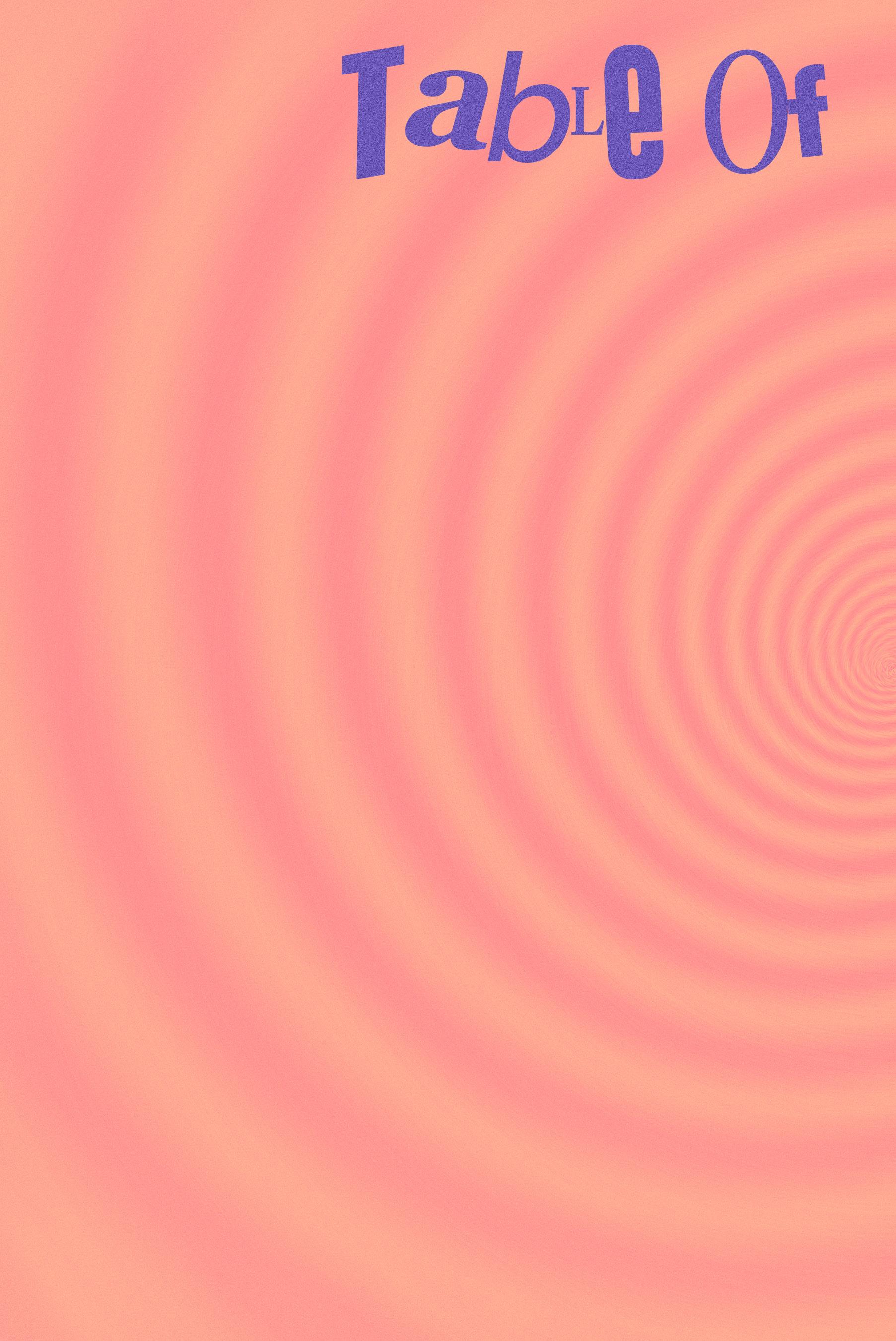





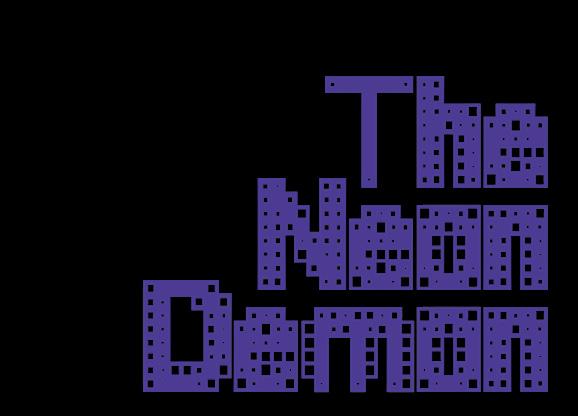
 Art by Youjin Choi
Art by Youjin Choi
 Art By Charlotte Benson
Art By Charlotte Benson

































 Words by Hannah Rossi Art by Nidhi Malpani
Words by Hannah Rossi Art by Nidhi Malpani




